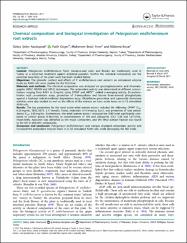Chemical composition and biological investigation of Pelargonium endlicherianum root extracts
Abstract
Context: Pelargonium endlicherianum Fenzl. (Geraniaceae) roots and flowers are traditionally used in Turkey as a decoction treatment against intestinal parasites. Neither the chemical composition nor the potential bioactivity of the plant roots has been studied before. Objectives: The phenolic content and effects of P. endlicherianum root extracts on antioxidant enzyme levels on A549 cells were studied for the first time. Materials and methods: The chemical composition was analyzed via spectrophotometric and chromatographic (HPLC MS/MS and HPLC) techniques. The antioxidant activity was determined at different concentrations ranging from 0.001 to 2 mg/mL using DPPH center dot and ABTS center dot(+) radical scavenging activity, beta-carotenelinoleic acid co-oxidation assay, protection of 2-deoxyribose and bovine brain-derived phospholipids against a hydroxyl radical-mediated degradation assay. Glutathione peroxidase and superoxide dismutase activities were also studied as well as the effects of the extracts on nitric oxide levels on IL-1 beta stimulated A549 cells. Results: The key parameters for the most active ethyl acetate extract included the following: DPPH center dot IC50: 0.23mg/mL, TEAC/ABTS: 2.17mmol/L Trolox, reduction: 0.41mmol/g AsscE, and protection of lipid peroxidation IC50: 0.05 mg/mL. Furthermore, the ethyl acetate extract increased the SOD level significantly compared to control group (4.48U/mL) at concentrations of 100 and 200 mu g/mL SOD, 5.50 and 5.67 U/mL, respectively. Apocynin was identified as the major component, and the ethyl acetate fraction was found to be rich in phenolic compounds. Discussion and conclusion: Pelargonium endlicherianum root extracts displayed antioxidant activity and increased the antioxidant enzyme levels in IL-1 beta stimulated A549 cells, while decreasing the NO levels.


















